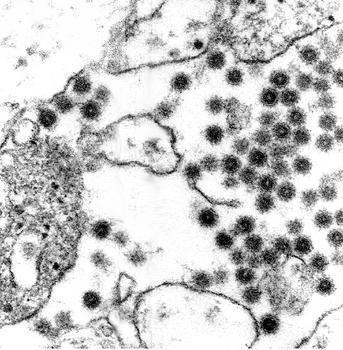
This virus is one of many members of the Alphavirus genus of Togaviridae. It is considered to be one of the most pathogenic mosquito-borne viruses in the United States.
Transmission: Mosquito-borne. Animal based transmission cycle occurs between birds and mosquitoes. Calisteta Melanura has been implicated as the most important mosquito vector for this virus.

Eastern Equine Encephalitis Virus. Source: F.A. Murphy.Visuals Unlimited. |
Epidemiology: Transmission occurs between birds and mosquitoes and then mosquitoes infect humans. Horses can also be infected and die. It is seen primarily within the eastern United States with the highest number of cases occurring in New Jersey, Massachusetts, Florida, and Georgia. Animal based transmission is most common in coastal areas and freshwater swamps and human cases are rare with a total of 200 reported cases within the United States since 1964 with an average of 4 cases each year.
Disease Presentation: Symptoms range from mild and flu-like to severe encephalitis, coma, and death. The fatality rate is reported to be 35% and of the people who do survive, 35% have some sort of neurological deficit. People under 15 or over 50 years of age usually have more serious disease.
Prevention: There is an equine vaccine, but no human vaccine currently exists. Prevention for humans includes avoiding mosquito-infested areas, using mosquito repellant with DEET, and wearing protective clothing.
Treatment: None